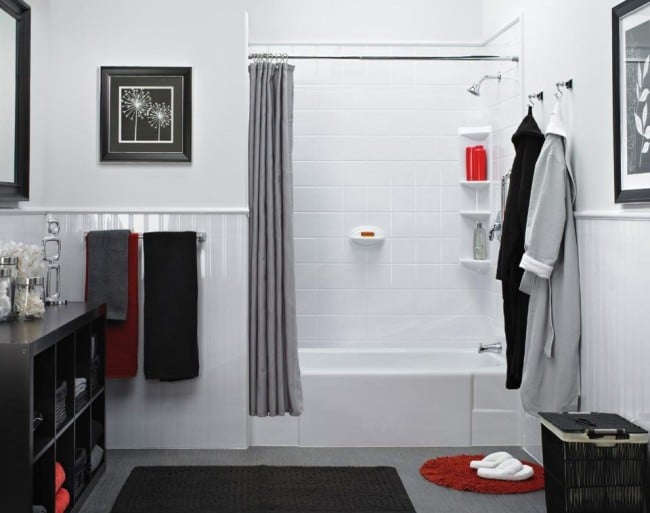5 Acrylic Shower Room Troubles and also Solutions
5 Acrylic Shower Room Troubles and also Solutions
Blog Article
{Source This Article What're your concepts on Finding the Right Plumbing Expert? We recommend that you clean your acrylic bathing product made of Delta ProCrylic or Acrylic with Innovex Technology with non-abrasive soaps and cleaners, such as: When it’s time to clean, always use a terry cloth towel, soft cloth or sponge to avoid scratching the acrylic surface. Don’t use abrasive scrubbing pads, steel wool or sponges, cause permanent damage to the acrylic material. If you use a drain cleaner or clog remover, be sure to rinse thoroughly with water so no product is left standing near the drain. Some chemicals and cleaners may deteriorate acrylic surfaces, causing cracks and, potentially, property damage. To avoid this, don’t use cleaning products that state on their label that they are not suitable for use on Acrylic, ABS, Polystyrene or Plastic. Be sure to check the label of any product before you apply it to the surface; it’s easier to avoid damage than to try to remedy it. Chemicals we do not recommend using to clean acrylic showers/tubs: When you’re ready to apply sealant, a little planning goes a long way. Pick up some painter’s tape and use it to mask off the seam to help make cleaning up easier. When you’re applying the bead, use a constant, steady speed to avoid an uneven finish. Use a caulk tool or a plastic spoon to work the sealant into the joint. Wetting the tool with denatured alcohol will help create a smooth finish. Follow the directions on the back of the tube for cure time. Certain chemicals and cleaners may deteriorate acrylic surfaces, causing cracks and, potentially, property damage. After you’re finished applying it, clean up the product surface and remove any excess sealant with denatured alcohol. Don’t use solvents (turpentine, lacquer thinner, mineral spirits, paint thinner, MEK, xylene, acetone, naphtha, etc.) that can wreak havoc on an acrylic surface. With a little care and consideration, you can prevent damage to your acrylic shower or tub. Keep a supply of soft cloths handy and remove any damaging products or abrasive scrubbing items from the bathroom to ensure they aren’t around when it’s time to clean. https://www.deltafaucet.com/design-innovation/inspiredliving/how-to-clean-acrylic-shower I found that post about Finding the Right Plumbing Expert while browsing on the web. Sharing is nice. You won't know, you may very well be helping someone out. Thank you so much for your time spent reading it.
Polymer baths, shower trays, and also other acrylic washroom ware have actually ended up being more usual in bathrooms in current times. Thanks to modern chemistry we now have choices to enamel and ceramic materials for washroom fixtures. These consist of different polers and also plastic materials. Not as durable as well as elegant as enamel as well as porcelain baths as well as fixtures, they are a lot more affordable and serve pretty much the exact same standard objective. These products are very easy to make, shop, and transport and in the incidence of damages, they are conveniently fixed. Some usual instances of damages to acrylic shower room components consist of discoloration, fractures, openings, etc. Allow's have a look at a few of these issues as well as quick ways of fixing them.Bath Staining
With long term use of acrylic bathrooms comes discoloration or staining. While some spots can be removed conveniently, utilizing unique chemicals, others need that the bath be resprayed. It is necessary to note that bleach or detergents do extremely little in removing such staining and they might also intensify it. Most times, these cleaning up agents cause staining in time. Aromatherapy oils loosen up the dirt in many cases thereby bring back the bathroom to its previous glory. Cleansing and also polishing likewise occasionally. For even more persistent spots, you will require a new layer of coating. This type of fixing will certainly require an expert.Chain reaction
In some cases, individuals try to paint the entire surface of their acrylic bathroom on their own either due to the fact that they do not like the color to conceal imperfections. However, when they do not like the outcome, they apply paint eliminators. You ought to never utilize paint cleaner on acrylic baths. Although paint cleaners do not react with the surface of metal baths, they ruin acrylic baths irreversibly. This develops a lot more benefit the professional. The most effective strategy below is to call a professional for aid with changing the bathroom.Scraped shower or bath surface area
Acrylic restroom fixtures are not abrasion-resistant like enamel selections. They are much more prone to scrapes and also less resilient. Being a really soft product, acrylic scratches can also be concealed without covering or dental filling. For these, you must seek specialist assistance for your bathroom fixings. As a prevention tip, prevent using unpleasant sponges when cleaning. Rather, you must use an easy fluid cleaner with a soft pad.Broken Polymer Baths
The life expectancy of acrylic as well as fiberglass baths is up to 15-20 years for shower pans as well as baths, normally. Fractures in an acrylic shower tray are most likely among the simplest issues to repair for a repair work specialist. This is the same for PVC, material, and also various other such products.
Polymer baths, shower trays, and other acrylic bathroom ware have become much more common in bathrooms in current times. With extended use of acrylic baths comes staining or discoloration. You need to never ever use paint remover on acrylic bathrooms. Paint cleaners do not react with the surface of steel baths, they destroy acrylic bathrooms irreversibly. The life expectancy of acrylic and fiberglass bathrooms is up to 15-20 years for shower frying pans and also baths, usually.How to clean Acrylic shower
USE THESE NON-ABRASIVE CLEANERS
DO NOT USE THESE CLEANERS
Sealant Application Tips

Schedule A Service Call